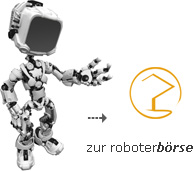Loading and unloading of machines
Automated assembly of a lathe
![[Translate to English:] Bestückung einer Drehmaschine durch einen KUKA KR16 Roboter Automation_FAMAG_Drehmaschine_Roboter_KUKA KR16](/fileadmin/_processed_/2/1/csm_KUKA_KR16_Automation_Drehmaschine_1_5950ca3539.jpg)
![[Translate to English:] Lagerichtige Ablage der Werkstücke in Kisten durch einen Roboter Automation_FAMAG_KUKA_KR16_Ablage](/fileadmin/_processed_/d/1/csm_KUKA_KR16_Automation_Drehmaschine_2_da5f8fb5c5.jpg)
Automation solution for loading and unloading lathes.
The FAMAG robotics and automation team has already implemented a large number of projects where the automatic loading and unloading of a lathe was the main topic. This is also an important point in our own production of FAMAG drills.
That is why the criteria of cost-effectiveness and reliability are central to the implementation of the automation solution for the FAMAG Robotics and Automation team.
In the example you see:
Feeder vibratory feeder / vibrating pot
Lathe
Robot-KUKA KR16
The process flow:
The workpieces to be processed are poured as bulk material into a vibratory feeder. The vibratory feeder guides the workpieces in the correct position to the robot. This places the workpieces in the lathe. The processing starts with closing the machine door. After completion of the processing, the robot removes the workpiece again. The workpieces are deburred via a spindle and then stored in the correct position in boxes provided.
In addition to this possibility to load and unload a lathe, you can also design a discharge with pallets or trays. This allows you to avoid impact marks or bending points on the turned parts. Through a cleaning station, the turned parts could be freed of chip or be specially cleaned by an ultrasonic bath or by a suction for the further process. You would like a number / data matrix code or similar on your workpiece? How about a laser marking? An example of this can be found here.
Pick and place on milling machines or machining centers
![[Translate to English:] Roboter KUKA KR6 Automation mit einer Fraesmaschine Automation_FAMAG_bearbeitung_fräsmaschine_Roboter_KUKA_KR6](/fileadmin/_processed_/1/8/csm_Automation_KR6_Fraesmaschine_Reinigung_Bad_2_83f4d8e797.jpg)
![[Translate to English:] Roboter KUKA KR6 setzt Werkstück in Reinigungsbad Automation_FAMAG_KUKA_KR6_Tauchbad](/fileadmin/_processed_/6/1/csm_Automation_KR6_Fraesmaschine_Reinigung_Bad_4_57fa64f880.jpg)
Automation solution for loading and unloading milling machines or machining centers
With milling machines and modern machining centers, entrepreneurs have many options for producing even surfaces or complex three-dimensional shapes - by removing material.
An automation with an industrial robot is particularly worthwhile here, as the production process is optimized through its repeat accuracy and constant work rhythm.
In the example you see:
Feeder Tactical Table
Discharge conveyor
Robot KUKA KR6
The process flow:
Workpieces are prepositioned into the cell via the cycle table, the robot removes them and places the workpiece in the chuck. The robot drives out of the machine. Processing is starting. After processing, the workpiece is cooled in a water bath and deposited on the conveyor belt. The workpieces are conveyed outside the cell into a box via the conveyor belt.
Optional extensions here too:
Automate plastic injection molding machines
![[Translate to English:] ABB IRB1400 entnimmt Werkstücke aus einer Kunststoffspritzgießmaschine Automation_kunststoffspritzgiessmaschine_roboter_ABB IRB1400](/fileadmin/_processed_/8/2/csm_Kunststoffspritzgiessmaschine__ABB_IRB1400_Automation_39947be64c.jpg)
Automation solution for loading and unloading of plastic casters
From the sheathing, rubber coating and pure casting - plastic casters are many.
Here you can see a realized project of the team FAMAG Robotics and Automation.
In the example you see:
Discharge conveyor
Plastic injection molding machine - type pouring
Robot ABB IRB1400
The process flow:
The plastic injection molding machine pours the shape of the workpieces. After the cooling process, the robot removes two workpieces from the machine. Removes the injection molding web and places the workpieces on a conveyor belt for further cooling. The conveyor belt cycles the cooled workpieces out of the cell.
Palletizing
![[Translate to English:] Depalettierung mit einem KUKA KR180 Palettieren_FAMAG_KUKA_KR180](/fileadmin/_processed_/c/7/csm_KUKA_KR180_Palettieren_ee13f3364a.jpg)
Automation solutions for loading and unloading pallets
Without much repacking - directly into the machine. No lifting, bending or stretching. In our example, you see a robot packing a pallet and then stacking the EU pallets.
In the example you see:
Robot KUKA KR180 PA
The process flow:
An EU pallet with the raw parts for production is driven into the cell with a pallet truck. After closing the cell, the robot begins to depalletise the EU pallet. After completion of the depalletization, the robot places the EU pallet at the final destination. A new filled EU pallet can be made available.
Removal from a press
![[Translate to English:] Pressen Handling Automation_FAMAG_Presse_Roboter](/fileadmin/_processed_/e/d/csm_Foto_Internet_Roboter_Pressen_e78e4eda2b.jpg)
Automation solutions for loading and unloading presses
Pressing - this manufacturing machine has a number of manufacturing processes, which can have fatal consequences for the wrong handling of people.
These manufacturing processes are:
- Joining (pressing in)
- separating (cutting)
- Forming (deep drawing)
- prototypes (pressing of powders)
In the example you see:
Robot NACHI SC15F AX 10
Magazine - adjustable for several blanks (at least 30 parts) with electr. Interrogate
The process flow:
Loading two different presses. Removal of the part from a magazine. Heating the part in an inductor. Insert in press. After swaging, the part is removed and placed in a box. With the small press, the parts automatically fall into a box after swaging

